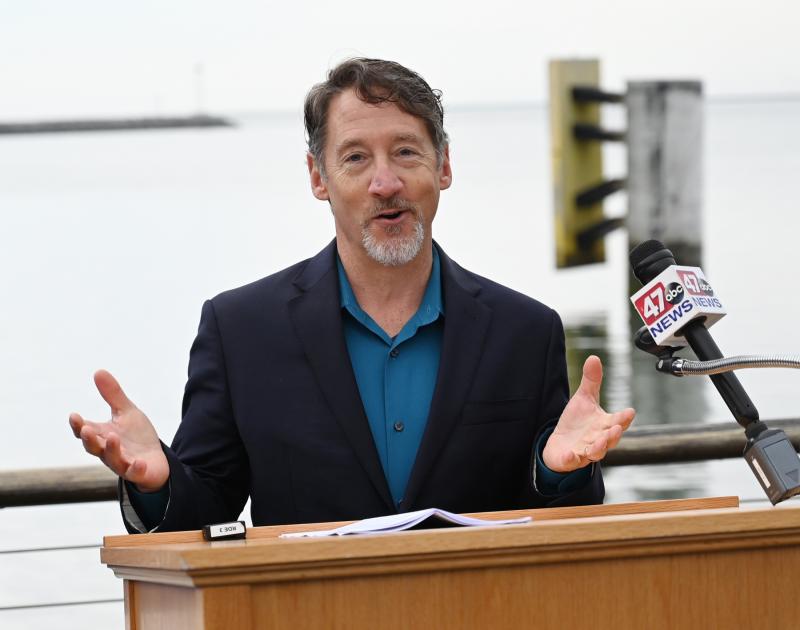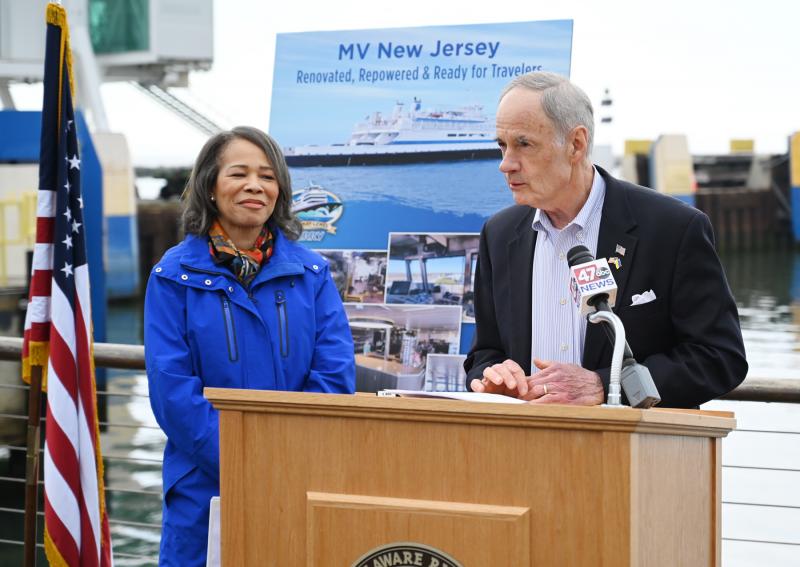Lewes ferry receives funds for master plan
The Delaware River and Bay Authority has received a $600,000 federal grant to continue its mission to make its ferry operations cleaner and more environmentally friendly.
Sen. Tom Carper and Rep. Lisa Blunt Rochester visited the Cape May-Lewes Ferry terminal March 25 to announce the grant from the U.S. Department of Transportation Maritime Administration’s America’s Marine Highway Program. They were joined by Lewes Mayor Ted Becker, DRBA Director of Ferry Operations Heath Gehrke and Southern Delaware Tourism Executive Director Scott Thomas.
The grant supports a new master plan for deploying modern, efficient and cleaner ferry boats in the First State. The master plan will include a comprehensive analysis of operations and service needs to help determine the types, sizes and number of ferries needed in the future. To support the nationwide push toward a low-carbon future, the ferry system will also be capable of incorporating technologies within the vessels – such as electric vehicle charging stations – that benefit consumers and the environment.
The bipartisan Infrastructure, Investment and Jobs Act will enable ferry systems like DRBA to accelerate work to enhance service and improve sustainability, Carper said.
“Ferries take cars off the road, provide a quick, scenic way to travel, and support local tourism industries,” Carper said. “Last fall, we recognized the important role that ferries have in our nation through the historic investments we included in the bipartisan infrastructure law. By making ferries an even cleaner and more energy-efficient mode of transportation, we can reduce emissions and support good-paying jobs. I’m pleased to see these investments directly benefit the Delaware River and Bay Authority’s ferry system, which has a major impact on the economy here in Sussex County.”
“The Cape-May Lewes Ferry has been a key part of Delaware’s identity and tourism engine for decades. Today’s investment in the Delaware River and Bay Authority will take our ferry system to the next level, developing a modern, clean and efficient fleet,” said Blunt Rochester. “These are exactly the kinds of investments that we envisioned when voting to pass the bipartisan infrastructure law last year – allowing DRBA and the Delaware ferry system to flourish and thrive for decades to come.”
The master plan will contain an analysis of various vessel characteristics, including smaller sizes, faster vessels, alternate propulsion systems and environmentally friendly considerations (alternative fuels, hybrids, electric, etc.); as well as how proposed designs interface with existing shoreside infrastructure. The review will also provide associated costs as well as the advantages and disadvantages of the options.
“The Cape May-Lewes Ferry has a substantial positive impact on our local economy,” Becker said. “In fact, a recent study indicated that ferry passengers spend a minimum of $125 million annually at Delaware beaches, and less than 5 percent of all ferry passengers report driving through the area without stopping for something, even if it’s just for gas or takeout. It’s important that the Cape May-Lewes Ferry continue to serve the twin capes region for years to come.”
For years, DRBA has been working to make its fleet more efficient with a smaller carbon footprint. The MV New Jersey, one of three vessels in the Cape May-Lewes Ferry fleet, recently returned home following a year in Staten Island, N.Y., where it underwent a $20.2 million comprehensive overhaul and repowering. The MV New Jersey’s new engines are expected to reduce emissions by 40 percent. The project included a $3 million grant from the Federal Transit Administration.
“This repowering and the renovations during this dry docking were the most comprehensive, complex and expensive ferry project in more than two decades,” Gehrke said.
The upgrades are expected to save DRBA about $130,000 annually in maintenance costs associated with the old World War II-era engines.
In addition to engine upgrades, the entire exterior of the MV New Jersey was water blasted and repainted. Crews also replaced steel bulkheads and exterior windows, and renovated and modernized the passenger galley area. The underwater hull was sandblasted and new smokestacks were fabricated.
To learn more about DRBA and the Cape May-Lewes Ferry, go to drba.net or cmlf.com.
Nick Roth is the news editor. He has been with the Cape Gazette since 2012, previously covering town beats in Milton and Lewes. In addition to serving on the editorial board and handling page layout, Nick is responsible for the weekly Delaware History in Photographs feature and enjoys writing stories about the Cape Region’s history. Prior to the Cape Gazette, Nick worked for the Delmarva Media Group, including the Delaware Wave, Delaware Coast Press and Salisbury Daily Times. He also contributed to The News Journal. Originally from Boyertown, Pa., Nick attended Shippensburg University in central Pennsylvania, graduating in 2007 with a bachelor’s degree in journalism. He’s won several MDDC awards during his career for both writing and photography. In his free time, he enjoys golfing, going to the beach with his family and cheering for Philadelphia sports teams.

























































